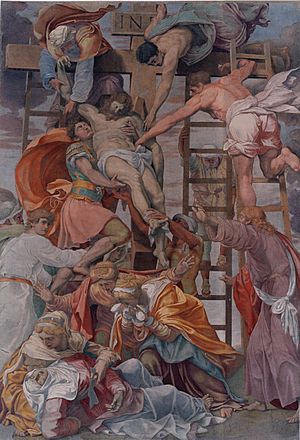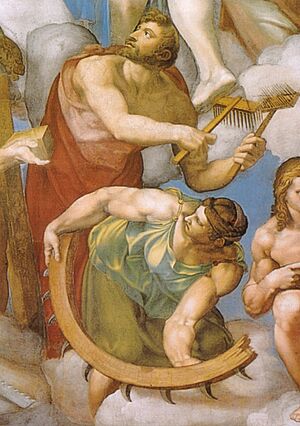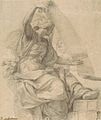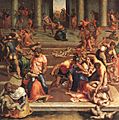Daniele da Volterra facts for kids
Quick facts for kids
Daniele da Volterra
|
|
|---|---|
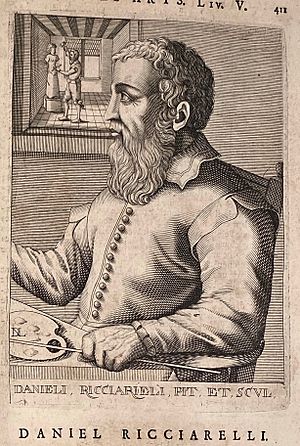 |
|
| Born | c. 1509 |
| Died | 4 April 1566 (aged 56–57) |
| Nationality | Italian |
| Known for | Painting |
| Movement | Mannerist |
Daniele Ricciarelli (born around 1509 – died April 4, 1566), also known as Daniele da Volterra, was an Italian painter and sculptor. He was part of the Mannerist art movement. This style came after the High Renaissance and often featured exaggerated forms and dramatic colors.
Daniele is most famous for his connection to the great artist Michelangelo. Many of Daniele's important artworks were based on ideas or drawings that Michelangelo gave him. Daniele also became known as Il Braghettone, which means "the breeches maker." This nickname came from a special job he did for the Pope.
Contents
About Daniele da Volterra
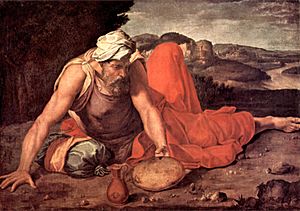
Daniele Ricciarelli was born in Volterra, a town in what is now Tuscany, Italy. When he was young, he studied art with other painters like Il Sodoma and Baldassare Peruzzi. However, things did not go well with them.
Around 1535, Daniele went to Rome. There, he helped paint beautiful pictures on walls, known as frescoes, in a building called the Palazzo Massimo alle Colonne. He then became a student of another artist named Perino del Vaga.
From 1538 to 1541, Daniele helped Perino paint more frescoes in different places in Rome. He also worked on a long painting in the main hall of the Palazzo Massimo alle Colonne. This painting showed the life of an ancient Roman hero named Fabius Maximus.
In Rome, Daniele also started working with Michelangelo and they became good friends. Michelangelo was a very famous artist. He used his influence with Pope Paul III to help Daniele get important art jobs. Daniele even became the supervisor of art projects at the Vatican. He kept this job until the Pope died. Michelangelo also gave Daniele sketches for some of his paintings.
After Pope Paul III died in 1549, Daniele lost his job and his income from it. After this, he spent most of his time creating sculptures. Daniele died in Rome in 1566.
Famous Artworks
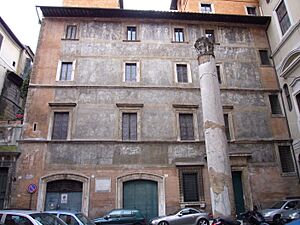
Daniele's most well-known painting is Descent from the Cross. You can see it in the Trinità dei Monti church in Rome. He painted it around 1545, using drawings by Michelangelo. This painting was once considered one of the most famous artworks in Rome.
Another important work is his painting of David killing Goliath. This painting is in the Louvre Museum in Paris. For a long time, people thought Michelangelo painted it himself. This shows how good Daniele was at using Michelangelo's ideas.
Other famous works by Daniele include:
- Massacre of the Innocents (1557) in the Uffizi Gallery in Florence.
- A portrait painting of Michelangelo.
- A sculpture bust he made from Michelangelo's death mask.
Daniele also created a sculpture called Cleopatra which is in the Belvedere. He was asked to make a large bronze statue of King Henry II riding a horse. Daniele only finished the horse part. This horse was later used for a statue of another king, Louis XIII. However, that statue was melted down during the French Revolution.
The Loincloths in Michelangelo's Last Judgment
Daniele da Volterra is famous for a special job he did on Michelangelo's masterpiece, The Last Judgment. This huge fresco is on the wall of the Sistine Chapel in the Vatican. Some people thought the figures in Michelangelo's painting showed too much skin.
So, Daniele was hired to paint clothes over some of the nude figures. This is why he got the nickname "Il Braghettone" ("the breeches-maker"). He added loincloths and draperies to cover parts of the bodies.
He also changed parts of the fresco by removing some of the original painting and repainting figures. For example, he changed a large part of Saint Catherine and the entire figure of Saint Blaise behind her.
Daniele's work on The Last Judgment stopped in late 1565. This was because Pope Pius IV died, and the chapel was needed quickly for a new pope to be chosen.
Legacy
Daniele da Volterra taught other artists, including a painter named Michele Alberti.
Daniele Ricciarelli is a distant relative of Christian Orlandi, an Italian actor and director.
Images for kids
-
Sybil (c. 1540–1545); Hermitage Museum, Saint Petersburg
-
Madonna with Child, young Saint John the Baptist and Saint Barbara (c. 1548); Uffizi, Florence
-
Moses on Mount Sinai (1545–1555); Gemäldegalerie Alte Meister, Dresden
-
Massacre of the Innocents (c. 1557); Uffizi, Florence
See also
 In Spanish: Daniele da Volterra para niños
In Spanish: Daniele da Volterra para niños


